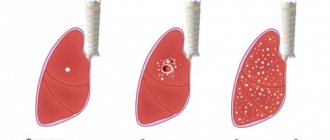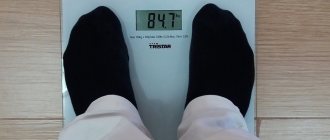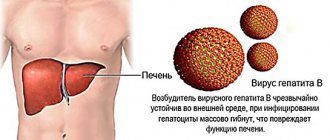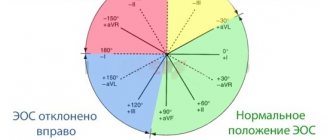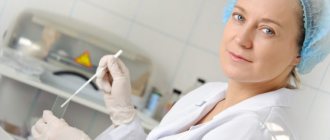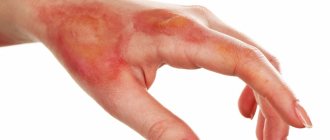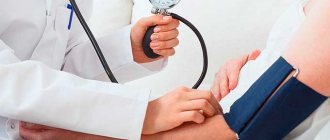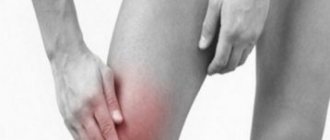Complications of lumbago 694
Lumbar lordosis is one of the natural curves of the spinal column. Normally, the human spine is not completely straight. It has 4 main bends. They are formed during the first year of a baby's life. They are responsible for a more uniform distribution of shock-absorbing and mechanical loads along the spinal column during movements.
Normally, lordosis of the lumbar spine is a breakdown anteriorly, due to which the sacrum is abducted posteriorly and the volume of the pelvic cavity increases. With this position of the vertebrae, an even distribution of the shock-absorbing load is ensured. Posterior abduction of the sacrum is necessary for the correct positioning of the iliosacral joints in coordination with the hip joints of the bones. The special arrangement of all these elements of the musculoskeletal system provides reliable protection against destruction and deformation of cartilage tissue.
Pathologies of lumbar lordosis can be caused by both poor posture and the consequences of various diseases of the spinal column and surrounding tissues. In particular, straightening is mostly formed due to incorrect posture and the habit of slouching. And increased lordosis is almost always associated with degenerative dystrophic processes in the area of cartilage tissue of the intervertebral discs and large joints of the lower extremities.
This article describes the main types of postural disorders in the lumbar spine and the potential causes that provoke these pathologies. Information is also provided on the possibilities of conservative treatment and correction of the condition of the spinal column using manual therapy methods.
What is lordosis?
Modern statistics say that every second person on the planet has poor posture. However, spinal curvatures are not the final problem. Thus, postural deformations often lead to serious diseases of the spinal column, as well as the organs of the thoracic and abdominal cavities. Sometimes spinal pathologies provoke compression of the spinal cord or complicate childbirth in women.
A newborn normally has a completely straight back. By the 2nd month, when the child begins to hold his head up, the first anterior curvature of the spine appears - cervical lordosis. By the age of six months, children sit up independently. Such a load provokes posterior deformation of the spinal column - thoracic kyphosis. When the child begins to walk, the last changes in the spine occur - lumbar lordosis and sacral kyphosis.
The described changes are completely completed by the age of 18 and form an anatomically correct spinal column. The formation of the latter is a physiological adaptation of a person to upright walking.
To summarize, lordosis is a normal or abnormal anterior curvature of the spine. Physiological is considered to be lordosis of the neck and lower back, which forms before the age of 20 (until all growth zones of the body close).
In some cases, pathological lordosis may form. It is often observed in the same parts as in the normal body. Usually we are talking about excessive “bend” (hyperlordosis) or smoothing of the bend (hypolordosis). Rarely, lordosis occurs at chest level, where the norm is a “convexity” of the back posteriorly – kyphosis.
Abnormal curves form throughout life as a consequence of pathologies of the spine, hip joints, as well as the muscles of the back and legs. Typically, the vertebrae of the affected area move forward: their bodies move away, and the intervertebral spaces widen. In this case, the processes of the vertebrae of neighboring sections come closer together.
If these changes appear in childhood, curvatures of the chest cavity and pelvis are observed, accompanied by compression of organs and disorders of their functioning.
Lordosis (physiological and pathological)
6 Diagnostics
- Combine vodka (1/4 cup), honey (100 g), salt (2 spoons), grated radish (0.5 cup). Rub the resulting pulp onto the spine, leave under the film for 5-10 minutes.
- Massage
- Oral administration, intramuscular injections, injections
It is usually performed only if conservative therapy is ineffective, as it is associated with a certain risk. The essence of one of the operations is that the pathological curve of the lower back is “forcibly” straightened and fixed in this position with the help of metal structures. The second operation is that the intervertebral discs are replaced with implants, which will be a good replacement for “slanted” discs, thereby eliminating pathological bend. Such operations are currently performed using small incisions, when visibility of the surgical field is provided by a fiber optic device, the image from which is displayed on a monitor.
Causes
Lumbar lordosis can be complicated by the following diseases and conditions:
Useful exercises:
- Subjectively, the course of lordosis is accompanied by pain in the lower back - pulling, aching. Subsequently, the pain intensifies, and symptoms of lordosis develop, such as a decrease in range of motion, deterioration of sensitivity in the lower extremities, and, as a result, difficulty walking. The situation is further aggravated by the fact that the knee and hip joints suffer secondarily, in which arthrosis changes develop. Deformation of the spine in the lumbar region leads to increased intra-abdominal pressure, digestive disorders, and constipation. Similar changes in the pelvis in girls and women are a direct path to menstrual irregularities, infertility or miscarriage.
- Injuries accompanied by damage to the lower back muscles, fracture of one or more vertebrae;
- play sports;
- The belly becomes bulging forward.
- 6.1 Diagnostic process
- For a speedy recovery at home, it is necessary to engage in physical therapy every day, as recommended by a specialist. Regularity of training, as well as adherence to their regimen, is extremely important. Proper nutrition and giving up bad habits significantly affect the condition of tissues and cartilage, so a healthy lifestyle in case of spinal diseases is a prerequisite.
- useful in preparing the spine for procedures to straighten it. The most popular types of massage for pathological lordosis are acupressure, lymphatic drainage, and classical therapeutic. Due to the improved blood supply to the muscles, they warm up, lymph flow and outflow of venous blood improve. In order to improve the general condition of the patient, massage can also be performed as an independent measure.
- in the spinal area of non-steroidal anti-inflammatory drugs, muscle relaxants, analgesics, anesthetics, glucocorticosteroids.
- You can prevent the development of lumbar lordosis if:
- herniated disc;
The exercises are complemented by massage treatments. The massage is carried out according to the generally accepted scheme (stroking, rubbing, kneading, vibration) in order to relax pathologically tense back muscles. Lymphatic drainage, acupressure types of massage are aimed at improving blood and lymph flow in problem areas. In cases of severe lordosis caused by obesity, muscle diseases, or pregnancy, a bandage is indicated to secure the lumbar spine.
If the lordosis is smoothed, then this also does not bode well for the patient. Due to the pinching of nerve fibers in the openings between the vertebrae, they become inflamed, and then the destruction of the outer myelin sheath (demyelination) occurs. The spinal canal narrows. This causes irreversible neurological damage. Patients complain of constant pain in the lower back, decreased sensitivity in the lower back and lower extremities, and lameness. Subsequently, control over urination and bowel movements is lost. Hypolordosis of the cervical spine impedes the flow of blood to the brain through the vertebral artery. This leads to complaints such as general weakness, dizziness, sleep disturbances and motor coordination.
- Osteoporosis of vertebral bone tissue due to calcium metabolism disorders;
- eat properly and balanced;
- When moving, the body and pelvis tilt backward.
- 6.2 Diagnosis at home
- If you do not have the necessary sports equipment or exercise equipment, you can use the following exercises:
- Osteopathy
Taking B vitamins
Symptoms
timely treat diseases of the joints and spine; degenerative
Modern functional adjustable lumbar bandage for lordosis
Diagnosis of lordosis in most cases is not difficult. The disease can be suspected based on the characteristic changes described above. To confirm existing suspicions, a simple x-ray of the spine taken in a lateral projection is sufficient.
Damage to the vertebrae of a tuberculous nature;
is not in one position for a long time;
Treatment
Prolapse of the abdominal organs, as well as their dysfunction, are observed.
- 7 Treatment of lumbar lordosis
- lie on the floor, bend your knees and place them on a chair. The angle between the hip and knee should be about 90 degrees. Place your left hand under the spine in the painful area, after which, relaxing and straining, you should try to bring your back closer to the floor. To do this, you can pull in your stomach, move your pelvis, etc. Repeat daily for 10 approaches during the day;
- effective in correcting posture in children; With the help of manual pressure on all parts of the spine, muscles are strengthened and correct posture is formed, especially in the initial stages of pathological lordosis.
- or intramuscular injections.
pay attention to your own posture;
inflammation of the above joints;
- In cases of severe lordosis with severe neurological complications that cannot be treated with drugs, surgical treatment of lordosis is indicated. During the operations, plastic surgery and fixation of curved areas are performed. Prevention of lordosis is aimed at eliminating its causes. Preventive measures include the fight against obesity, schoolchildren maintaining correct posture, playing sports, and timely treatment of diseases that are potentially dangerous in terms of the development of lordosis.
- The main diagnostic criterion here is the angle between the upper surface of the 1st lumbar and 1st sacral vertebrae. Normally, this angle is 150-170 degrees. A decrease in this angle indicates an increase in lordosis, an increase indicates that the lordosis is straightened.
- Tumor processes in the spine;
- periodically strengthen the abdominal muscles;
- When the first signs of lumbar hypo or hyperlordosis appear, you should consult an orthopedist or vertebrologist. After a visual examination and conversation with the patient, the specialist will prescribe an additional examination, which will establish the fact of pathology of the lumbar spine.
- 7.1 Surgical treatment
lie on your back, arms to your sides. Raise your legs up and throw them behind your head;
Manual therapy and traction
External use of ointments
if the job is sedentary, you need to get up once an hour and stretch the muscles of your back and legs;
MoyaSpina.ru
compression of the spinal cord in the canal;
Types of lordosis
In the modern classification, cervical and lumbar lordosis are distinguished. In these areas, a normal bend can be observed - physiological lordosis, as well as pathological - hypo- or hyperlordosis.
Considering the causative factors, pathology is divided into primary (associated with disorders in the spine) and secondary (which develops as an “adaptation” to maintain balance in response to unusual conditions).
If the patient can straighten his back independently, we are talking about unfixed lordosis. When straightening is difficult or impossible, the curvature is considered partially or completely fixed.
Why does pathology appear?
The development of spinal curvature at an early age can be facilitated by:
- malformations, hip dislocations or hip dysplasia;
- cerebral palsy (due to lack of oxygen to the brain during the peripartum period);
- rickets (metabolic disorders with vitamin D deficiency);
- polio (a viral disease that affects the nervous system).
In older age, lordosis is provoked by:
- inflammatory diseases of the spinal column;
- dystrophic disorders of the spine (osteochondrosis, etc.);
- tumor neoplasms;
- spondylolisthesis (sliding displacement of the vertebrae);
- spinal injuries;
- diseases of the nervous system (torsion dystonia - irregular increase in the tone of individual muscle groups);
- pathologies of the hip joint (dislocations or immobility - ankylosis);
- pregnancy (temporary bend, which is associated with an increase in the mass of the pregnant uterus. Corrected after childbirth).
Typically, certain groups of the population are susceptible to the development of lordosis:
- Teenagers prone to rapid growth;
- Office workers and representatives of other professions who are forced to sit at their desk for a long time;
- Women who prefer high heels;
- People suffering from abdominal obesity (with predominant deposition of fat on the abdomen, when the waist circumference exceeds 85 centimeters);
- Workers with excessive physical activity (circus actors, loaders, etc.);
- Former athletes who abruptly stopped training, or people with little physical activity;
- Patients with chronic pathologies of the musculoskeletal system.
The noted diseases, pathological conditions and other changes in the body are associated with a redistribution of the center of gravity: it shifts forward, as a result of which the spine bends in the lower back. As a rule, the remaining parts of the spinal column also become compensatory.
Causes
The reasons for the development of lordosis differ in children and in adult patients. The main factors that can provoke a deepening of physiological curvature in adults are:
- injury to the back and hip joints;
- diseases of the skeletal system;
- muscle weakness;
- overweight;
- lack of vitamins and protein in the body;
- spinal tumors;
- spondylitis
Lordosis in children most often occurs during the period of active growth at the ages of 2 to 6 years and from 10 to 14 years, the reason for this is weakness of the back muscles. In children, diseases such as cerebral palsy, rickets, hip dysplasia and Kashin-Beck disease can provoke the development of lordosis. Obesity and uncomfortable sitting at a desk during classes can lead to the formation of the disease. Often, extra pounds also cause the development of scoliosis in children and cardiac dysfunction.
Symptoms
The first manifestation of lordosis is a strong bend (or vice versa straightening) of the lower back. Such changes are temporary at first - they are corrected by the patient independently - until the lordosis becomes permanent - fixed.
Typically, curvature of the spine is accompanied by rapid fatigue and pain in the affected area. In this case, the pain intensifies when playing sports or staying in uncomfortable positions for a long time. Over time, the spine loses its flexibility, which limits the patient's movements.
Hyperlordosis of the lower back and neck can be accompanied by pathologies of the cardiovascular, respiratory and gastrointestinal systems. This is due to compression or impaired circulation of the relevant organs. In some cases, abnormal lordosis can complicate pregnancy and childbirth.
As mentioned above, primary spinal deformities are usually compensated by secondary ones.
Such changes lead to the formation of characteristic posture:
- A round and concave back (kypholordosis), which is characterized by deepening of the lordosis of the lower back and kyphosis of the chest. The stomach is protruded, the shoulders are pulled together and raised, the shoulder blades protrude, and the head is tilted forward. The joints of the lower extremities can be either straightened or bent, which is why the gait changes - it becomes a “duck” or a sliding one.
- A round back (isolated kyphosis), characterized by increased thoracic curve and straightening of the lumbar – hypolordosis. At the same time, the body weight shifts back, which is why the legs are constantly bent at the knees in order to maintain balance. The head moves forward, the shoulders are brought together and raised, the shoulder blades stick out. The chest is sunken and the stomach is protruded.
- Plano-concave back associated with the alignment of the curvature of the neck and chest. In this case, the lumbar curve is normal or compensatory increased. The joints of the lower extremities are extended, the chin is lowered. The shoulders are pulled together, the shoulder blades stick out, the chest is sunken.
- “Board-shaped” back, characterized by the alignment of all curves of the spinal column. The chest is slightly shifted forward, and the lower abdomen protrudes.
The most common type of spinal curvature is lumbar hyperlordosis. Typically, such changes lead to the formation of kypholordotic posture.
It is worth noting that violations of the axis of the spinal column are accompanied by inadequate distribution of the load on the osteoarticular and muscular systems of the body: the ligaments are under tension, muscle spasm is observed. As a result, complications appear in the form of hypermobility of the vertebrae and their instability, intervertebral hernias, spondyloarthrosis and inflammation of the lumbar muscles - psoitis. In rare cases, compression of the spinal cord, as well as dysfunction of the pelvic organs, is observed.
Lordosis of the lumbar and cervical spine: exercises, symptoms, causes and treatment + PHOTO
Reasons
Consequences of cervical and thoracic hyperlordosis for humans
After diagnosis by a doctor and a disappointing verdict - it has been smoothed out, the lordosis needs to be treated. This process is primarily aimed at eliminating the cause of pathology in the lumbar region. If lordosis is caused by excess weight, then it is necessary to take measures to correct metabolism, as well as resort to diet therapy.
10 Conclusion
Measures to prevent lordosis are effective not only in childhood, but also when performing sedentary work, as well as in the presence of spinal diseases:
Diagnostics
The operation boils down to mechanical straightening of the spine, dissection of abnormally fused vertebrae and their fixation using metal structures.
Unfortunately, this type of surgery leads to immobility of the damaged segments of the spine; Currently, methods are being widely implemented in which flexible implants are installed that can preserve the mobility of the spinal column. UHF
The most severe consequences observed with fixed hyperlordosis of the spine are deformation of the chest, which results in problems with the gastrointestinal tract (constipation, intestinal obstruction, duodenal ulcers), as well as deterioration in the functioning of the lungs and heart. Complications of excessive lordosis manifest themselves especially quickly in children and adolescents.
Treatment of pathological lordosis
Therapy for pathology can be conservative and surgical. Conservative therapy for lordosis consists of a complex of effects:
Hypolordosis Surgical
- Cerebral palsy - cerebral palsy; Symptoms
- If the curvature occurs due to lumbar osteochondrosis or coxarthrosis, then a special course of medications, exercise therapy and physiotherapy is prescribed. One If you look closely at a person’s figure, you can see that the back has a curved shape. It is this that gives the human skeleton this position.
- In any situation, maintain correct posture. Physical A special set of exercise therapy classes has been developed aimed at improving posture, strengthening the back muscles, and straightening both lumbar and cervical lordosis. The first sessions of therapeutic exercises are usually carried out in a medical institution with a professional instructor.
Non-drug methods
- Lordosis accelerates the development of diseases of the spine and joints, resulting in premature aging and destruction of hyaline cartilage.
- 1) Drug treatment of lumbar lordosis. In this case, anti-inflammatory and painkillers are prescribed, usually in the form of ointments or gels, and in tablet form. So, a good combination is the use of Voltaren Emulgel and Indomethacin tablets.
Most often, a smoothed lordosis of the lumbar region develops. The neck is a more mobile part of the body and less susceptible to disease. This manifestation of the disease is also called hypolordosis. Its main features: Among All these remedies for lordosis play a supporting role - they improve metabolic processes in the tissues of the spine, eliminate pain and inflammation, but do not affect the lordosis itself. But physical therapy strengthens the muscular-ligamentous apparatus, eliminates pathological muscle tension and thereby significantly corrects the curved spine.
- Hip dysplasia;
- Treatment
- In severe forms of deviation, lordosis is treated with surgery, especially if it is straightened. In this case, the patient’s lumbar curve is quickly straightened using a special metal structure, which is designed to fix the operated area. Due to the introduction of new technologies, surgeons often practice a new method of treating lumbar and cervical lordosis - this is the implantation of artificial implants instead of spinal discs.
Lordosis is formed in the spinal column from the first days of a person’s life, which allows you to evenly distribute the load on the spine, and also performs a shock-absorbing function during physical activity. Create Exercises include:
- pain relief, reducing the load on the affected part of the spine and forming correct posture may include: Constant
- 2) B vitamins are also used: “Neurovitan”, “Neurorubin”. pain
- Exercises for lordosis are carried out according to the following method: Injuries
- There are 3 types of spinal curvatures that develop in 2 planes. Lateral curvature in the frontal plane is scoliosis. And in the sagittal (antero-posterior) plane, lordosis (anterior curvature) and kyphosis (posterior curvature) are distinguished.
This operation is performed using endoscopic equipment. The spinal discs are removed from the department, and metal plates are installed in their place, which provide fixation of the plastic support. This support performs the shock-absorbing and motor function of the disk.
Of course, there is a certain norm of natural lumbar curve, deviations from which will be regarded as a disease or pathology. It may be smoothed out or overly pronounced.
Exercise therapy in therapy
Consume a lot of vegetables and fruits rich in nutrients.
classes for stretching ligaments and tendons;
- wearing special corsets, bandages;
- To make a diagnosis, an external examination of the patient and some tests are often sufficient.
- 3) The drugs “Mydocalm” or “Sirdalud” will help to relax the muscles that have “pinched” the spine in one position.
feeling of numbness in the back, especially in the morning;
Folk remedies
In a standing position, bend your feet forward, shoulder-width apart, trying to reach the floor with your fingers;
- Rickets;
- It is noteworthy that lordosis, like kyphosis, is not always a pathology. It all depends on the degree of curvature. The bottom line is that our spinal column is not perfectly straight. It is even (or almost even) in newborns. Then, by the first year of life, when the child begins to walk and the gravitational load on the spinal column increases, these curves also increase - 2 kyphosis (thoracic and sacral) and 2 lordosis (cervical and lumbar). All these curvatures reduce the load on the spine and, to some extent, prevent damage to it.
Lifestyle with lumbar or cervical hyperlordosis
Hypolordosis and hyperlordosis are diseases that can be either congenital or acquired.
Lordosis exists in two pathological forms - lumbar hypolordosis and hyperlordosis.
- Reduce weight in case of obesity.
- warm-up of all groups of joints, especially the knees and hips;
- sleep on orthopedic mattresses;
- At the initial stages of the development of pathological lordosis, abnormalities in the curvature of the spinal column are often not visualized, so it is necessary to perform an X-ray examination in direct and lateral projections in bent and extended positions.
4) Physiotherapeutic procedures to improve blood supply to the spine and relax nearby muscles. Used: magnetic therapy, electrophoresis, thermal procedures.
How to prevent the development of the disease?
back compaction;
- Stand with your back to a flat horizontal surface and try to press your heels, buttocks, shoulder blades and the back of your head against it as much as possible;
- Kashin-Beck disease is a severe disease with impaired bone tissue formation;
- So the presence of lordosis is not yet a pathology, of course, if it is not very pronounced. It is the degree of severity that is the main difference between physiological (normal) lordosis and pathological one. Primary and secondary lordoses are distinguished according to the mechanism of development. Primary lordosis is caused by pathology of the spinal column and nearby muscles. The main causes of primary lordosis:
- Of course, when lumbar lordosis developed pathologically in the womb, then it is no longer possible to do without the intervention of specialists in the structure of the spinal region. It’s another matter when a person himself leads a sedentary lifestyle and is not physically active. As a result, he acquires such a sentence as lumbar lordosis or hyperlordosis is straightened.
- Hypolordosis is quite rare and occurs when the physiological lordosis is straightened. Most often, this pathology occurs in elderly people, since the cause is chronic osteochondrosis of the lumbar region.
- Practice a healthy, active lifestyle, doing exercises to strengthen the muscles, spine, and joints.
sustavok.ru
How to diagnose lordosis?
You can diagnose lordosis yourself. To do this, you need to stand on a flat vertical surface, pressing the back of your head, shoulder blades, sacrum and heels against it. A palm is passed into the space between the vertical surface and the lower back. Normally, the hand passes with some effort. If the palm could not be advanced or if it passed easily, one can suspect insufficient or excessive deflection, respectively.
In an outpatient setting, the diagnosis is made after a thorough clinical analysis and X-ray examination. During the examination, the patient’s posture is assessed and the necessary tests are performed to determine the fixation of lordosis and the involvement of nervous tissue in the process. In addition, the muscular frame of the back is palpated, and the organs of the chest and abdomen are also examined.
As a matter of routine, X-rays of the spine are taken in two projections, as well as in positions of full flexion/extension of the back. The specialist evaluates the structure, location and configuration of the vertebrae, their mobility. Sometimes (if the x-ray is inconclusive) a computed tomography scan is required.
Symptoms
Signs of lordosis of the thoracic region, especially in the later stages of development of the pathology, can be distinguished visually, since the appearance and posture of the patient undergo significant changes . In particular, the following manifestations of pathology are observed:
- Shortening the neck , the head moves forward a little;
- The chest becomes flatter , and a rounding of the abdomen is noted;
- Shoulders move forward;
- The gait changes , and in a sitting position, a person’s legs move apart at the knees;
- Over time, pain in the back , limited mobility in the affected area, pain intensifies during movement or with prolonged stay in an uncomfortable position.
Treatment of lordosis
The goal of therapy is to eliminate the root cause of lordosis, as well as correct the deformity of the spinal column. Patients are assisted by specialists in vertebrology and orthopedics.
Medicines
Non-steroidal anti-inflammatory ointments and gels are recommended for local treatment of lordosis, but they must be prescribed by your doctor. (Nimesulide, Dilofenac, Methyl salicylate) or products with capsaizone and menthol. Patients are also prescribed a course of muscle relaxants that relieve muscle spasms (Arduan, Baclofen, Mydocalm). B vitamins (Neurobion) are used as general strengthening therapy.
Physiotherapy
Among the physiotherapeutic procedures for lordosis, magnetic therapy, UHF and paraffin applications are prescribed, which can increase blood flow in the affected area and also eliminate muscle spasm.
Exercise therapy and massage
Therapeutic exercises are an integral part of the treatment of lordosis. Thus, for each clinical case, an individual selection of physical exercises is carried out, aimed at strengthening certain muscle groups.
In the non-acute period of lordosis (when the underlying disease is cured or is in remission), a course of massage is recommended to reduce muscle tension and enhance local metabolism.
Orthopedic rehabilitation
In some cases, patients are recommended to wear special posture correctors - bandages or corsets designed to additionally support and relieve the spinal column. The type of correctors and duration of use are determined by a specialist depending on the specific clinical case.
Surgical intervention
The indication for surgery is primary lordosis caused by malformations, tumor processes, injuries and other pathologies of the spine itself. Typically, surgical intervention is reduced to fixing the vertebrae with special metal structures, after which patients face a long postoperative period. The difficulty of the operation is the proximity to the spinal cord, which is why the intervention requires a qualified spinal surgeon.
Treatment at home
Treatment of lordosis at home is carried out using 3 methods:
- Gymnastics.
- Massage.
- Application of an orthopedic bandage.
A bandage is a special device in the form of a corset. It fixes the curved parts of the spine and prevents further deformation. The size of the bandage is selected by the doctor. He also advises the patient about the wearing time.
Massage. Sessions can be carried out both at home (if you invite a specialist) and in massage rooms.
Prevention
Preventative measures for lordosis include preventing the development of spinal curvature at an early age by:
- correction of spinal malformations, as well as hip dislocations or hip dysplasia;
- prevention of cerebral palsy in the peripartum period;
- taking vitamin D to prevent rickets;
- timely vaccination against polio.
At older ages, it is recommended to diagnose and treat:
- inflammatory diseases of the spinal column;
- dystrophic disorders of the spine (osteochondrosis, etc.);
- tumor neoplasms;
- spondylolisthesis (sliding displacement of the vertebrae);
- back injuries;
- diseases of the nervous system (torsion spasms);
- pathology of the hip joint (dislocations/immobility - ankylosis).
Particular attention should be paid to the condition of the spinal column by people at risk: fast-growing adolescents (>10 centimeters per year), obese people, office workers, loaders, circus performers and former athletes. This risk distribution is associated with an increased load on the spinal column, a shift in the center of gravity, or insufficient development of the muscular frame of the back.
A separate class of those susceptible to lordosis includes pregnant women in whom spinal curvature occurs due to increased weight of the uterus. Normally, such curvature of the spine disappears with the birth of a child. However, lordosis that occurs before pregnancy can subsequently complicate childbirth.
Remember, lordosis is a pathology that threatens not only a pronounced cosmetic defect, but also subsequent pathologies of the spine and internal organs!
Why is scoliosis dangerous?
Scoliosis is no less dangerous than kyphosis or lordosis. The curvature of the spine can become so pronounced that it will be noticeable even to the naked eye. Moreover, the disease can lead to disruption of the functioning of some internal organs (lungs, heart).
Moreover, scoliosis can be easily diagnosed even by a person who does not have a medical education. To do this, children are undressed to the waist and their backs are examined. The room should be well lit so that shadows are not created in the spine area. It is best to examine the child's back from the bottom up. If it is short, then it can be placed on a stool.
To diagnose scoliosis correctly, children must relax, calm down and stand up straight. In children with the disease, usually one shoulder is higher than the other, the shoulder blades are also at different levels, and the shape of the spine itself is slightly curved.

